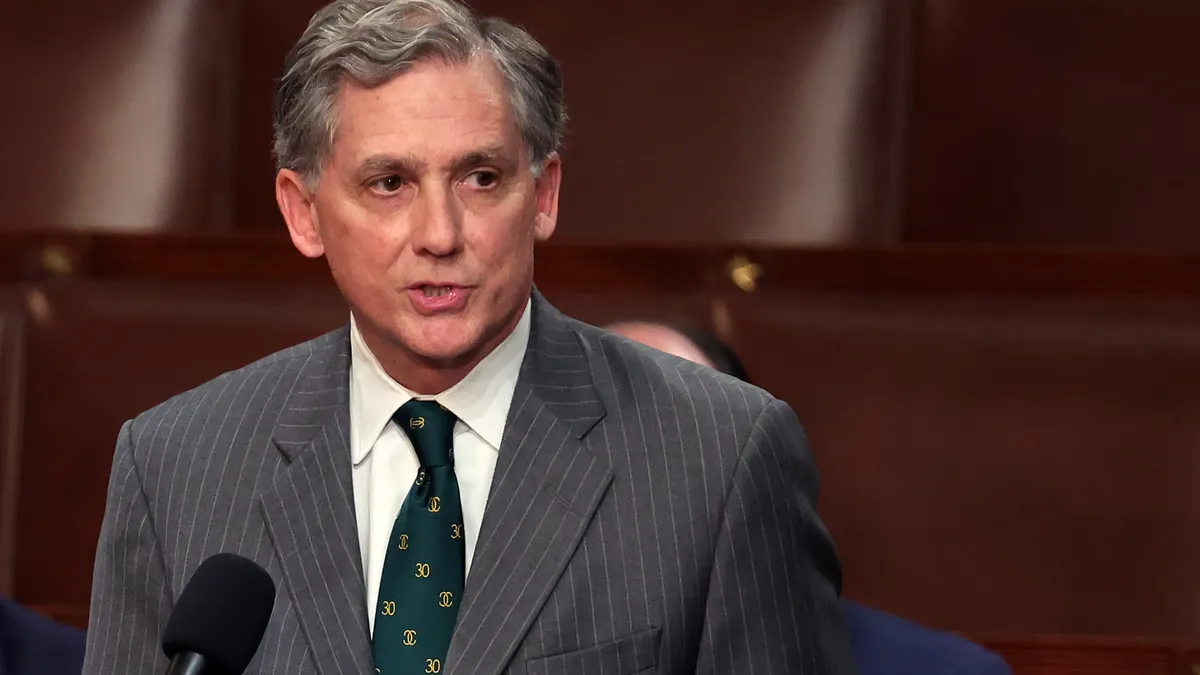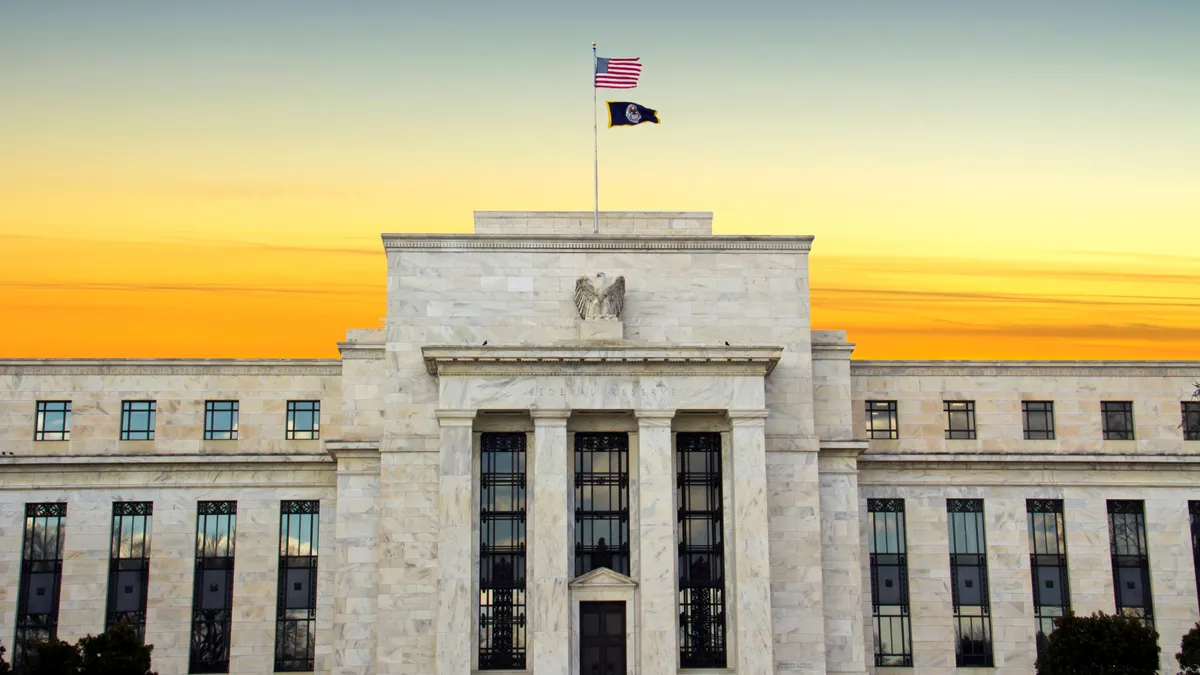A bipartisan group of lawmakers are prodding the Federal Reserve to expedite the expansion of interbank settlement hours, underscoring the potential to accelerate faster and safer payments for consumers, workers and businesses.
In a letter to Federal Reserve Chair Jerome Powell on Monday, the congressional group asked why the central bank isn’t planning to extend the U.S. payments system’s days of operation sooner than 2027, as planned. They also asked about other target dates considered, and what factors might allow for speeding up the plan.
House Financial Services Committee Vice Chair French Hill, R-AR, was one of the six lawmakers who signed the letter.
“Our goal is that the Fed take the progress that they've made on faster payments and improving the payment infrastructure, and advance the ability to go 24 hours a day, seven days a week, sooner than a date in 2027,” Hill said in an exclusive interview with Payments Dive on Monday.
The lawmakers are pressing the Fed to take up the slack in a U.S. payments system that sometimes takes days to complete a payment or transaction. Such lags rob consumers, businesses and government entities of financial gain and efficiencies that might come with an expansion of the system’s availability.
“The world has changed dramatically in the last 60 years, and this will save people money on accounts receivable and accounts payable, obviously, because you're speeding up the clearance time of a transaction, and removing the float from the transaction,” Hill said. “So, basically, the financial system is more efficient, more effective, and I think it gives consumers and businesses more control over their savings.”
Expanded operations
In May, the Fed proposed to increase the operating hours of its two big-value payments services, namely the Fedwire Funds Service and the National Settlement Service. As part of the proposal, the central bank said the interbank settlement services would stretch the number of days of operation to include holidays and weekends by 2027, meaning they would operate every day of the year by that time.
“We believe it is important for the Federal Reserve to prioritize its work and act swiftly to expand the operating days and hours of the NSS and Fedwire,” the lawmakers said in the letter.
In addition to Hill, Sens. Cynthia Lummis, R-WY, and Chris Van Hollen, D-MD signed the letter, in addition to Reps. Ayanna Pressley, D-MA; Young Kim, R-CA; and Nikema Williams, D-GA.
The lawmakers want to hear the Fed explain why it can’t speed up the timetable, Hill said. They don’t have a particular new target date in mind, and they’re not criticizing the Fed, but they’re trying to zero in on the barriers to completing the transition sooner, he said. They’re also probing as to whether the obstacles relate to infrastructure, technology, staffing, training or something else, he said.
The letter isn’t so much about expressing irritation with the Fed as it is about making progress on this issue.
“We are asking questions on behalf of consumers, and on behalf of American business, and on behalf of the fact that we're moving rapidly to a digital future,” Hill said. “What's the hold up between implementing this now?”
Upcoming testimony
The lawmakers are sending the missive ahead of Powell’s appearances Tuesday before the Senate Banking Committee and Wednesday in front of the House Financial Services Committee for semiannual monetary policy reports. They are asking for written answers to the questions posed in the letter by July 31.
Lawmakers have been pushing the Fed for nearly a decade on upgrades to the payments system, Hill said. The campaign picked up momentum after the launch last year of the U.S. real-time payments system FedNow, which moves payments in seconds as opposed to days. That followed the launch of the RTP network, a similar private-sector system, by The Clearing House in 2017. Those real-time systems complement Fedwire and the NSS in the broader payments ecosystem.
The lawmakers also noted in their letter that a new standard, ISO 20022, that is expected to simplify payments, will be in place for Fedwire by March 2025 — well before 2027.
The ACH electronic payments network can process and clear payments 23¼ hours of every banking day, but financial institutions using it are limited because they can only conduct interbank settlements when the Fed’s wholesale payments services from Fedwire and NSS are available, they said in the letter.
Consumers benefits
One of the specific benefits to consumers and employees of the expanded payments operation would be the ability to send direct deposits to workers on additional days, the letter said.
“It would also allow Americans to transfer money between accounts at night and on weekends and holidays,” the letter said.
That would let consumers avoid late fees and otherwise benefit from more efficient payments, the letter noted.
Hill noted that consumers are already gravitating to other faster forms of payments, including those offered by Early Warning Services’ Zelle account-to-account services, PayPal’s Venmo peer-to-peer tool and cryptocurrencies.
The lawmakers met with Fed officials last year and asked how adoption of FedNow, which was launched last July, is advancing and received a response that it was “consistent but slow,” Hill said.
FedNow and RTP have both struggled to lure a broad array of banks to adopt the new instant payments systems, partly because they require an investment in technology, but also because some banks aren’t necessarily eager to set aside the financial float they benefit from as payments wait to settle.
Hill also pointed to a third reason.
“Part of that is caution, perhaps, about float, but it's also just caution about introducing a new service without doing the appropriate amount of consumer education,” Hill said. “I think the Fed is concerned about consumer education.”
That’s especially true when it comes to educating consumers about a rise in scams where they’re tricked into sending money to crooks. There is an increased risk with real-time payments, given they’re irrevocable. That payment fraud issue has sparked debate on Capitol Hill and among regulators.
The lawmakers also asked in their letter about how the Fed is viewing the logical next step, extending U.S. payments services to 24 hours per day. The Fedwire service operates 22 hours per day, and the NSS closes a half-hour earlier.
In an April Fed staff memo regarding the extension of the two systems’ operating days, there was no mention of the rationale for the 2027 target date. The memo said the Fed has the round-the-clock ideal percolating.
“While this proposal is focused on an expansion to 22x7x365, an expansion to full 24x7x365 operating hours for the Fedwire Funds Service and NSS remains a consideration for the future,” the April 15 memo said.
This month, the Fed extended the public comment period on its proposal by two months to Sept. 6.





















